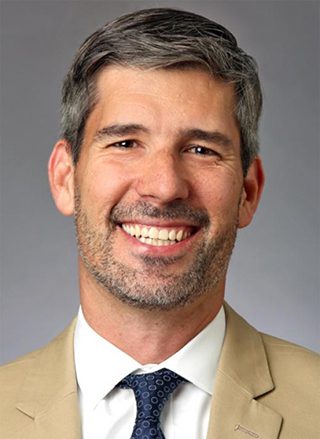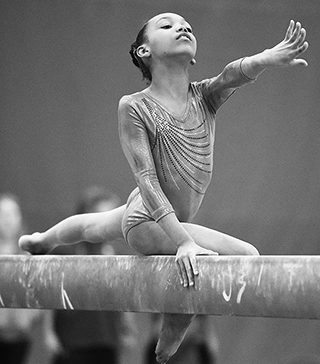Stretching the Limits: How an Elite Gymnast with Scoliosis Stays Competitive
After Olivia Kelly was diagnosed with scoliosis, her team at NewYork-Presbyterian developed a non-surgical treatment plan that allowed her to keep pursuing her gymnastics dreams.
Ask 18-year-old gymnast Olivia Kelly to name her favorite gymnastics event and she doesn’t hesitate. “The beam is the most graceful out of the events,” she says. “And I really enjoy flipping around on the beam.”
The balance beam is an unforgiving 4-inch wide apparatus that requires balance, precision, and perfect alignment to execute a 90-second routine. Even the slightest shift in her posture, and Olivia could fall.
So imagine what a worsening curve in Olivia’s spine could do to her routine, her training, and her Olympic dreams. When persistent back pain in 2022 led to a diagnosis of scoliosis — a condition that causes a lateral curve in the spine — as well as a stress fracture in her lower back, Olivia was unnerved. “The main concern when I was diagnosed with my scoliosis was that I wouldn’t be able to do gymnastics to the same capacity,” says Olivia, who was 16 at the time. “I was nervous that my gymnastics career would take a detour.”
Dr. Benjamin Roye, a pediatric orthopedic surgeon at NewYork-Presbyterian Morgan Stanley Children’s Hospital and Och Spine at NewYork-Presbyterian, offered her a path forward.

Dr. Benjamin Roye
Inspired by his patient’s discipline and willingness to challenge herself, Dr. Roye worked with Olivia to create a unique treatment plan that allowed her to stay competitive. He prescribed a corrective back brace, which Olivia wore for five to eight hours a day and when she slept, and the Schroth Method, a scoliosis-specific therapy that works to improve spinal alignment through stretching, strengthening, and breathing exercises. The all-around approach to Olivia’s scoliosis not only helped her manage the pain while continuing to train, but it also stabilized her 32-degree curve.
“We were actually working to straighten her back with two different but complementary ways,” says Dr. Roye. “This is really what allowed Olivia to continue living her dream.”
A Fierce Competitor
Olivia’s love for gymnastics started as a toddler. “In mommy and me classes there was tumbling and walking on little beams,” she recalls. By age 6, she was a competitive gymnast.
Inspired by 2012 all-around gold medalist Gabby Douglas, Olivia set her sights on standing on the Olympic podium. But she also wanted to honor her paternal family’s roots in the process by competing for Barbados, where her grandfather was born. “When Olivia tried out for the Barbados National Team, our whole family was proud of her,” says Olivia’s father, Tori, who helped his daughter secure dual citizenship.
Olivia has since represented Barbados at a host of events including the World Championships and the Pan American Championships. The high school senior from Mahwah, NJ, also juggles home school and a disciplined training schedule that includes 4- to 6-hour sessions, five days a week.
But when she was around 15, Olivia experienced a sudden onset of back pain she described as “very strange.” On the advice of her physical therapist, she went to get x-rays, and that’s when she learned she had a 32-degree curve in her lower spine, as well as a stress fracture that was compounded by scoliosis and her rigorous hours in the gym.

Olivia has been a competitive gymnast since she was 6.
Suddenly, “it was hard for me to find an alignment where I was in a straight back position, which can affect my training on the beam, bars, sometimes even my tumbling,” she says.
Her parents struggled to find answers as to how this could have happened. “When Olivia was diagnosed with scoliosis, the first thing that went through our mind as parents was, is it our fault? Did we miss something?” Tori says.
The answer was no. Scoliosis affects about 2% of children in the U.S. each year. Olivia was diagnosed with idiopathic scoliosis, the most common form of the condition for which the exact cause is unknown, though it often runs in families. Typically, it presents when children are going through puberty and rapid growth spurts. Instead of straight, the spine twists to one side as it grows, forming a curve that can range from slight to more severe. Corrective surgery is usually required if the curvature is greater than 50 degrees, but most cases, like Olivia’s, are moderate and fall under that benchmark.
On top of scoliosis, Olivia also has a spondylolysis, which is a stress fracture in one of the vertebrae of her lumbar spine. “While stress fractures are relatively common and scoliosis is relatively common as well, to see them both together is relatively uncommon,” says Dr. Roye, who is also an assistant professor of orthopedic surgery at Columbia University Vagelos College of Physicians and Surgeons. “So, we had to both manage her injury as well as her scoliosis at the same time.”
Striking a Balance
When Olivia told Dr. Roye that she did not want to take a break from gymnastics so that she could pursue her Olympic dreams, Dr. Roye thought about a treatment that allowed her to stay competitive while mitigating her scoliosis. “It’s very difficult to make curves get better or go away once they’ve been established, and they certainly can get worse over time,” says Dr. Roye. “[Olivia] was definitely at risk for continued progression, and we wanted to do what we could to prevent that.”
For the next 14 months, Olivia wore a back brace designed to hold her back in a straighter position, which would help reduce the curve in her spine as she continued to grow. In x-rays, “her curve, which measured a little bit over 30 degrees when she was out of the brace, measured under 20 degrees once she put the brace on,” says Dr. Roye. “That is a significant improvement.”
It came at a certain cost. “It felt like a bunch of plastic pushing me against my ribs,” admits Olivia. “I wore it when I was sleeping, which was a little bit uncomfortable, but I knew it was for the best.”
Once Olivia stopped growing, the brace was replaced with the Schroth Method, a form of physical therapy that specifically targets scoliosis. Developed in 1921 by German physical therapist Katharina Schroth, the Schroth Method focuses on breathing exercises that help patients elongate and support their spine.
Since last November, Olivia has been working twice a week with Mary Miceli, a physical therapist at NewYork-Presbyterian Westchester who is also certified in the Schroth Method. Miceli has been teaching Olivia different breathing exercises in various positions (sitting, standing, laying down), all in an effort to expand the areas of her spine that are compressed due to her scoliosis.
Miceli has even customized Olivia’s regimen to include certain gymnastics moves. “I make sure that when she goes into the gymnastics gym, she is in alignment when she’s doing certain techniques,” says Miceli.
The improvement was undeniable. “It’s actually been helping me stay on the beam a little bit more because I’m not crooked,” says Olivia. “It’s also been helping my posture a great amount, which is great for beam and floor.”
Olivia also practices Schroth Method outside the gym. “When I’m able to do the exercises that Mary has taught me in my everyday life, it reduces the pain so much,” says Olivia.
The ultimate goal is for the Schroth Method exercises to become more innate. “With Schroth therapy, it really is a way of life,” adds Dr. Roye. “This is not something that you do and you’re done. It’s something you carry with you.”
"I'm very grateful for NewYork-Presbyterian. Mary and Dr. Roy have helped me immensely throughout my scoliosis process, and I'm glad that I was able to find another option to help me achieve my goals."— Olivia Kelly
Standing Tall
While Olivia won’t be going to Paris for the 2024 Games, she will be competing at an elite level in the fall when she joins the University of Missouri gymnastics team. Overall, “her progress has been excellent,” says Miceli. “Her pain has improved. The long-term goal is to improve her posture overall.”
Luckily, Olivia ‘s curvature at the end of her growth period was well under 40 degrees, and studies show that curves that size at maturity typically don’t get worse over time.
“Olivia had a great response to treatment, and we really prevented her curve from getting significantly worse from where she started,” says Dr. Roye. “Because of that, she’s going to be able to continue her gymnastics career.”
“Olivia’s future will be exciting,” adds Tori. “I look forward to seeing the outcome — and I want to be there for every step.”
Says Olivia: “Hopefully, if my back holds up, I can get to the 2028 Olympics for Barbados. My goal always has been, and always will be, to be the best gymnast I can be. I’m very excited for my NCAA journey as well as the international journey to see what it has in store for me.”

